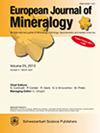基于再加热熔体包裹体及其橄榄石寄主组成的意大利索玛-维苏威火山镁质熔体挥发演化研究
IF 1.7
3区 地球科学
Q2 MINERALOGY
引用次数: 1
摘要
摘要索玛-维苏威火山是一座层状火山,对意大利南部那不勒斯市和周边城镇的人口构成地质灾害。从历史上看,索玛-维苏威火山(SV)的火山爆发包括高震级的普林尼火山爆发,比如公元79年那次臭名昭著的火山爆发,那次火山爆发发生在295年的平静之后,杀死了庞贝和周围城镇和村庄的数千人。SV最后一次喷发是在1944年,火山爆发指数(VEI)为3(喷发了0.01 km3的火山物质)。在1944年喷发之后,SV火山在过去的79年里一直处于休眠状态,只有轻微的火山喷发和地震活动。在其漫长的历史中,SV几个世纪的休眠随着普林尼火山喷发(VEI 6)而结束,这标志着新一轮喷发活动的开始。因此,当前的休眠阶段需要更好地了解高震级喷发的机制,以便更好地预测未来的喷发规模和风格。尽管对SV火山系统进行了几个世纪的研究,但仍然存在许多问题,包括岩浆挥发物从深层原始岩浆到较浅更进化的岩浆的演变。更好地了解与SV挥发性演化相关的物理和化学过程,可以深入了解岩浆动力学和触发SV高爆炸性喷发的机制。在这项研究中,我们基于对橄榄石中再加热熔体包裹体(MIs)的分析,提供了与SV的4次普林尼期和2次普林尼期间喷发相关的岩浆喷发前挥发物含量的新数据。我们通过考虑MIs中气泡的挥发性含量来校正含气泡MIs的挥发性含量。我们发现了两组MIs:一组以高fo橄榄石(Fo85-90)为宿主,挥发物相对丰富;另一组以低fo橄榄石(Fo70-69)为宿主,挥发物相对较少。寄主橄榄石挥发物含量与组成的对比表明,岩浆分馏发生在挥发物饱和的条件下,相对于演化程度较低/准原始的岩浆,分馏程度较高的岩浆位于较浅的层位。利用SV的Fo90橄榄石中含有的校正后的MIs的CO2含量,我们估计在过去3个世纪(总共38-75 Mt)的火山活动中,SV岩浆溶解了347 ~ 686 t d−1的岩浆CO2。虽然这项研究仅限于少数SV岩浆,但我们建议采用类似的方法进行进一步的研究,可以阐明MIs挥发性含量与喷发风格和年龄之间明显缺乏相关性。此外,这些研究还可以对CO2的来源以及碳酸盐岩台地与SV下上升岩浆之间的相互作用提供额外的约束。本文章由计算机程序翻译,如有差异,请以英文原文为准。
Constraining the volatile evolution of mafic melts at Mt. Somma–Vesuvius, Italy, based on the composition of reheated melt inclusions and their olivine hosts
Abstract. Mount Somma–Vesuvius is a stratovolcano that represents a geological hazard to the population of the city of Naples and surrounding towns in southern Italy. Historically, volcanic eruptions at Mt. Somma–Vesuvius (SV) include high-magnitude Plinian eruptions, such as the infamous 79 CE eruption that occurred after 295 years of quiescence and killed thousands of people in Pompeii and surrounding towns and villages. The last eruption at SV was in 1944 and showed a Volcanic Explosivity Index (VEI) of 3 (0.01 km3 of volcanic material erupted). Following the 1944 eruption, SV has been dormant for the past nearly 79 years, with only minor fumarolic and seismic activity. During its long history, centuries of dormancy at SV have ended with Plinian eruptions (VEI 6) that signal the beginning of a new cycle of eruptive activity. Thus, the current dormancy stage demands a need to better understand the mechanism involved in high-magnitude eruptions in order to better predict future eruption magnitude and style. Despite centuries of research on the SV volcanic system, many questions remain, including the evolution of magmatic volatiles from deep primitive magmas to shallower more evolved magmas. Developing a better understanding of the physical and chemical processes associated with volatile evolution at SV can provide insights into magma dynamics and the mechanisms that trigger highly explosive eruptions at SV. In this study, we present new data for the pre-eruptive volatile contents of magmas associated with four Plinian and two inter-Plinian eruptions at SV based on analyses of reheated melt inclusions (MIs) hosted in olivine. We correct the volatile contents of bubble-bearing MIs by taking into account the volatile contents of bubbles in the MIs. We recognize two groups of MIs: one group hosted in high-Fo olivine (Fo85–90) and relatively rich in volatiles and the other group hosted in low-Fo olivine (Fo70–69) and relatively depleted in volatiles. The correlation between volatile contents and compositions of host olivines suggests that magma fractionation took place under volatile-saturated conditions and that more differentiated magmas reside at shallower levels relative to less evolved/quasi-primitive magmas. Using the CO2 contents of corrected MIs hosted in Fo90 olivine from SV, we estimate that 347 to 686 t d−1 of magmatic CO2 exsolved from SV magmas during the last 3 centuries (38–75 Mt in total) of volcanic activity. Although this study is limited to only few SV magmas, we suggest that further study applying similar methods could shed light on the apparent lack of correlation between the volatile contents of MIs and the style and age of eruptions. Further, such studies could provide additional constraints on the origin of CO2 and the interaction between the carbonate platform and ascending magmas below SV.
求助全文
通过发布文献求助,成功后即可免费获取论文全文。
去求助
来源期刊
CiteScore
2.80
自引率
9.50%
发文量
40
审稿时长
6-12 weeks
期刊介绍:
EJM was founded to reach a large audience on an international scale and also for achieving closer cooperation of European countries in the publication of scientific results. The founding societies have set themselves the task of publishing a journal of the highest standard open to all scientists performing mineralogical research in the widest sense of the term, all over the world. Contributions will therefore be published primarily in English.
EJM publishes original papers, review articles and letters dealing with the mineralogical sciences s.l., primarily mineralogy, petrology, geochemistry, crystallography and ore deposits, but also biomineralogy, environmental, applied and technical mineralogy. Nevertheless, papers in any related field, including cultural heritage, will be considered.

 求助内容:
求助内容: 应助结果提醒方式:
应助结果提醒方式:


